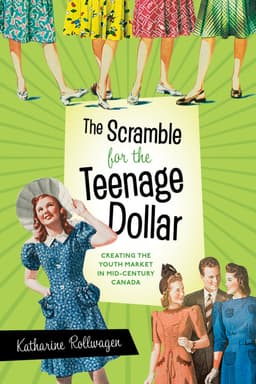
Book Review
The Scramble for the Teenage Dollar: Creating the Youth Market in Mid-Century Canada, 2025
By Katharine Rollwagen
Buy the book: https://www.ubcpress.ca/the-scramble-for-the-teenage-dollar
The Scramble for the Teenage Dollar: Creating the Youth Market in Mid-Century Canada discusses Canada’s burgeoning teen retail market from the 1930s, 40s, and 50s through the lens of retail marketing and advertising history. While the cultural understanding of the teenager (or teen) is prevalent in our current times, it is a relatively new phenomenon born out of the early twentieth century (9). As more young people became engaged consumers with their own purchasing power, retailers saw the potential for Canadian youth as a distinct and profitable market sector. Katharine Rollwagen argues that during this time, Canadian retailers were eager to introduce, legitimize, and attract the teenaged youth market to the growing consumer consciousness. Using well-known consumer magazines, mail-order catalogues, newspapers, and corporate archives, Rollwagen demonstrates how retail marketing messages changed over time to shape, guide, and mold the teenaged consumer, steering them towards an idealized Canadian image.
While other Canadian department stores and retailers are mentioned throughout the book, the primary focus of the book is the Eaton’s Department Store with its advertising and corporate archives. Rollwagen argues that Eaton’s attempted to appeal to the teenage market on a grander scale, unrivalled by their competitors (13). The evidence presented throughout the book suggests that Eaton’s poured a great deal of time, money and resources into understanding the teenager consumer and attracting them to their stores. This endeavour culminated in Eaton’s Junior Council (girls) and Junior Executives (boys), a unique focus group of enthusiastic, active, accomplished, and popular students who took part in weekly meetings at the store. High school students were screened through a thorough application process which included reference letters from high school faculty, lists of extra-curricular activities and social clubs, academic averages, part-time employment, household income, etc. High school principals were part of the selection process and were instructed on what to look for in the ideal student to represent the council; a well-rounded, well-liked student was more important than academic achievement in the selection process (134). By seeking out the most popular and engaged student base, Eaton’s attempted to tap into this profitable consumer market and help foster a new generation of loyal Eaton’s customers through peer influence.
The Scramble for the Teenage Dollar builds on an extensive array of Canadian, American, and British sources regarding this particular moment in consumer history. Katharine Rollwagen’s book draws inspiration from notable Canadian consumer historians such as Cynthia Comacchio, Doug Owram, Bettina Liverant, Valerie J. Korinek, and Donica Belisle. What Rollwagen brings is a thoroughly Canadian perspective regarding the emerging teenage consumer market of the 1940s and 50s that showcases the lengths some retailers were willing to go to in order to attract and influence this impressionable market base.
The book delves into the image of the ideal Canadian teenager as portrayed in popular magazines including Canadian Home Journal and Chatelaine. These magazines, Rollwagen argues, presents the Canadian teenager through the lens of the co-ed high school and university student. Through this image of intelligent, well-groomed, and accomplished young Canadians, these magazines could represent an ideal image for teenaged readers to aspire to. Beauty and style mattered above all else and success in all other areas of life would come from achieving this ideal look (36-7). Normal adolescent awkwardness and imperfections could be overcome with the right routine and/or the right products (41). This aspirational ideal was white and middle-class and it excluded young people of other races or those without financial means to keep up with the ideal lifestyle.
For those of financial means, consumption was seen as a mark of maturity and purchasing power as an important stage in a young person’s development. Retailers like Eaton’s wanted to portray young consumers as authoritative, knowledgeable, and engaged (57). However, young people, still developing a sense of self, community, and belonging, remained susceptible to fads and trends. Rollwagen’s book demonstrates how Eaton’s marketers used Junior Council and Executive members as commodities to promote the company’s image and boost sales (156). Eaton’s garnered real presence and influence in Canadian high schools, not only to promote the store and boost sales, but to stay on top of trends and influence peer groups. Rollwagen also points out that the Eaton’s store often had exclusive access to many of these high schools and used their influence to participate openly in discussion on how best to prepare students for the adult world (145).
Rollwagen’s in-depth and comprehensive analysis of how the Eaton’s department store tapped into the teenage consumer market through the use of its Junior Council and Junior Executive clubs is a real discovery and markedly the book’s greatest strength. She demonstrates a deep streak of paternalism amidst the celebration of teenage consumer agency. The first two chapters of the book, which discuss the more general topic of teenage culture and magazines’ depiction of them, seem to jar slightly with the rest of the book’s direction. The material of co-ed fashion in magazines and the concerns of teenage fads and immature consumer decisions could have been better connected to the Junior Council’s influence on teenage consumer choice.
Rollwagen’s decision to focus on one specific Canadian department store opens the doors for other historians to explore how different markets tapped into this growing and lucrative sector of the consuming public. It also opens further discussion on the impact and influence marketers have on young consumers. As Rollwagen discusses in her conclusion, the teenaged market is still highly sought after by marketers and advertisers. Further exploration could reveal even more insight into how the consumer market has affected adolescent development over time. The Scramble for the Teenage Dollar provides a thought-provoking glimpse into an aspect of Canadian consumer history. Rollwagen’s book is thoroughly researched and guides the reader through the development of Canadian teenage consumer culture.
Brandi Adams
University of Regina